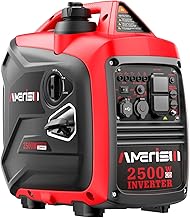How to Clean a Generator Carburetor: A Step-by-Step Guide
How Much Can a 7500-Watt Generator Run?
April 19, 2025Selecting the Appropriate Generator Size for a 200-Amp Service
April 19, 2025A generator carburetor plays a crucial role in mixing air and fuel for combustion. Over time, dirt, debris, and old fuel residues can clog the carburetor, leading to poor engine performance or even preventing the generator from starting. Regular cleaning of the carburetor ensures optimal efficiency and prolongs the lifespan of your generator. This guide will take you through the process of cleaning a generator carburetor step by step.

Signs Your Generator Carburetor Needs Cleaning
Before diving into the cleaning process, it’s important to recognize the signs of a dirty or clogged carburetor. Common indicators include:
- Difficulty Starting the Generator: A clogged carburetor prevents the proper fuel and air mixture from reaching the engine.
- Rough Idling or Stalling: The generator may run inconsistently, sputter, or shut off unexpectedly.
- Black Smoke from the Exhaust: This suggests an improper fuel mixture, often due to a dirty carburetor.
- Reduced Fuel Efficiency: A clogged carburetor can cause the generator to consume more fuel than necessary.
- Lack of Power Output: If the generator isn’t running at full capacity, the carburetor may need cleaning.
Tools and Materials Needed
To clean a generator carburetor, you will need the following tools and materials:
- Screwdrivers (Phillips and flathead)
- Socket wrench set
- Pliers
- Carburetor cleaner spray
- Clean rags
- Small brush or toothbrush
- Safety gloves and goggles
- Compressed air (optional, for drying)
- A container for draining fuel
Step-by-Step Guide to Cleaning a Generator Carburetor
Step 1: Safety First
Before beginning, ensure your generator is turned off and completely cooled down. Work in a well-ventilated area away from open flames. If your generator has fuel inside, drain it into a safe container.
Step 2: Locate and Remove the Carburetor
- Identify the carburetor, usually attached to the side of the engine near the air filter.
- Remove the air filter cover and the air filter to access the carburetor.
- Disconnect the fuel line using pliers and drain any remaining fuel into your container.
- Unscrew the mounting bolts and carefully detach the carburetor from the generator.
- Disconnect any linkages or throttle cables, noting their placement for reassembly.
Step 3: Disassemble the Carburetor
- Place the carburetor on a clean, flat surface.
- Remove the float bowl by unscrewing the bolts at the bottom of the carburetor.
- Take out the float and needle valve carefully.
- Unscrew the jets and nozzles to access clogged passages.
Step 4: Clean the Carburetor Components
- Spray carburetor cleaner generously into all openings, including the jets and fuel passages.
- Use a small brush or toothbrush to scrub away stubborn debris.
- Blow compressed air through the jets and passages to ensure they are free of blockages.
- Wipe all components with a clean rag.
Step 5: Reassemble the Carburetor
- Reinstall the jets and nozzles.
- Place the float and needle valve back in their correct positions.
- Secure the float bowl back onto the carburetor using the screws.
- Double-check that all components are securely tightened.
Step 6: Reattach the Carburetor to the Generator
- Align the carburetor with the mounting bolts and secure it in place.
- Reconnect the fuel line and throttle linkages.
- Reinstall the air filter and air filter cover.
- Ensure all connections are tight and secure.
Step 7: Test the Generator
- Refill the fuel tank if needed.
- Turn on the generator and check for smooth operation.
- Listen for any unusual sounds and observe if the engine runs consistently.
- If the generator still struggles, double-check the carburetor assembly and clean again if necessary.
Tips for Maintaining a Clean Carburetor
- Use Fresh Fuel: Stale fuel can lead to buildup and clogging. Use a fuel stabilizer if storing fuel for long periods.
- Run the Generator Regularly: Running the generator periodically prevents fuel from sitting too long in the carburetor.
- Clean the Air Filter: A dirty air filter can contribute to carburetor issues.
- Inspect the Carburetor Periodically: Check for any signs of dirt or corrosion and clean as needed.
Cleaning your generator carburetor regularly ensures smooth operation and extends the life of your generator. By following this step-by-step guide, you can maintain peak performance and avoid unexpected generator failures. If you’re unsure about any step, consult your generator’s manual or seek professional assistance.

